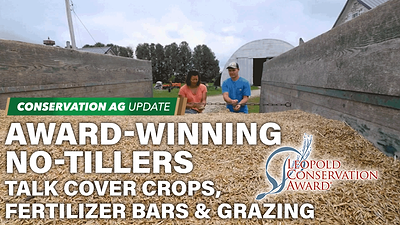Betsy Rowland had planned to incorporate strip-tilling and cover crops on her farm for years, but a program that paid her to do it made that decision a no-brainer.
The Princeton, Ill., farmer is getting direct payments through the Soil and Water Outcomes Fund, which matches farmers with organizations to fulfill environmental commitments, including carbon capture. Based in Ankeny, Iowa, the fund was created in 2019 and is a partner of AgOutcomes, a subsidiary of the Iowa Soybean Association.
“We bring a unique value proposition to farmers,” says Adam Kiel, fund managing director and AgOutcomes executive vice president. “The basic premise is to work with farmers to have them implement conservation practices that produce carbon and water quality outcomes.”
About 125 farmers enrolled 120,000 acres in 2021, most of which are in Iowa, Indiana and northern Illinois. Instead of cost-share, farmers receive per-acre payments for instituting practices considered environmentally friendly. Payments average $31 per acre.
Corporate clients include PepsiCo., Cargill and Nutrien Ag solutions. Government agencies and non-governmental organizations also participate.
“The board members, shareholders and NGOs are going to hold Pepsi accountable to their commitments,” Kiel says. “If they say they expect to be net-zero by 2050, Pepsi can’t reach their goals without working with farmers somehow in their supply chain to reduce greenhouse gas reductions.”
“We had nearly 15,000 acres enrolled,” says Megan Miller, agronomy manager with the Illinois Soybean Association. “Most added cover crops, reduced tillage or no-till. They sequestered 7,937 metric tons of carbon dioxide, which is comparable to removing 1,726 cars from the road for 1 year. We were happy about that.”
The water quality component sets the fund apart from similar initiatives.
“That’s one thing we really like,” Miller says. “With the Illinois Nutrient Reduction Strategy, we need to prioritize reducing nitrate and phosphate runoff, keeping nitrogen and phosphorus where you want it in field. In the pilot we were able to keep 214,605 pounds of nitrate from entering waterways and 8,342 pounds of phosphate from entering waterways as well.”
Rowland enrolled 5,000 acres last year and plans an increase this year.
There are no acreage limits. The program is limited only by commitments by corporate and other clients.
One advantage over government programs that offer cost-share for conservation practices is ease of application, Kiel says.
“We can get a farmer under contract in less than a week, even closer to 3 days,” he says. “Some farmers say they’ve been waiting 6 months to get under contract with EQIP (the Environmental Quality Incentives Program administered by USDA’S Natural Resources Conservation Service). This is a much more streamlined approach.”
While it is unlikely farmers can actually make money on enrolled acreage, the payments may cover costs of putting acreage in the program. A survey of farmers in the program revealed that most reported the payments covered their costs. Nitrogen-producing legumes sown as cover crops could make an economic impact.






